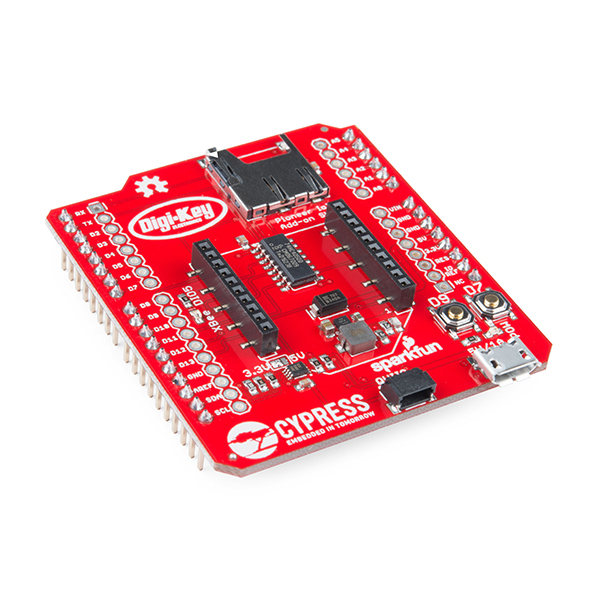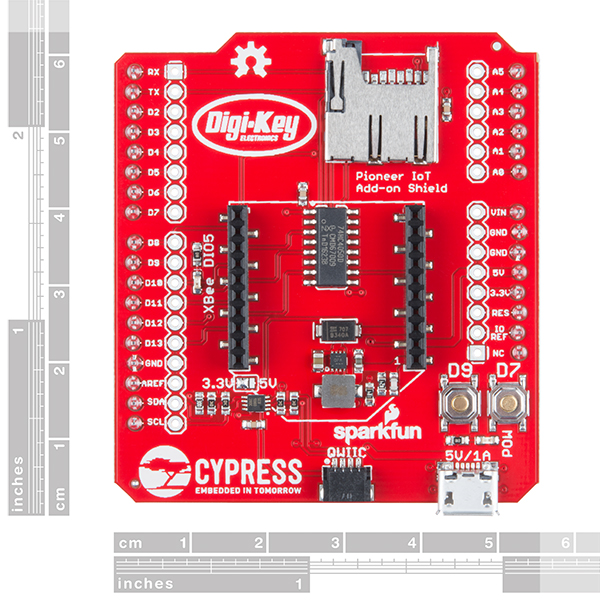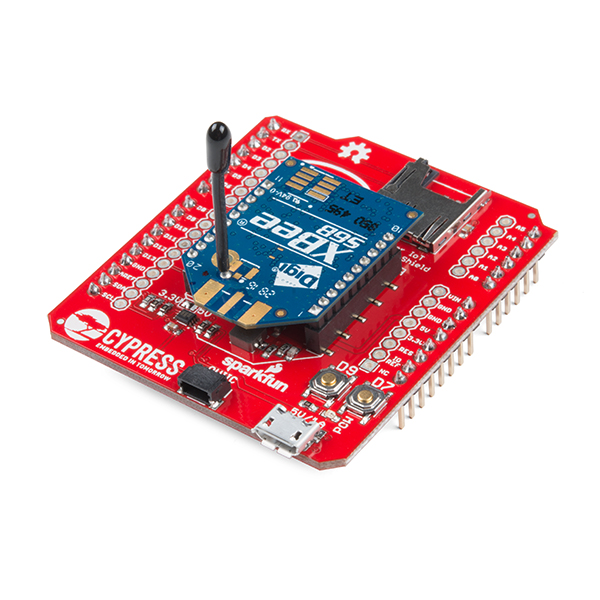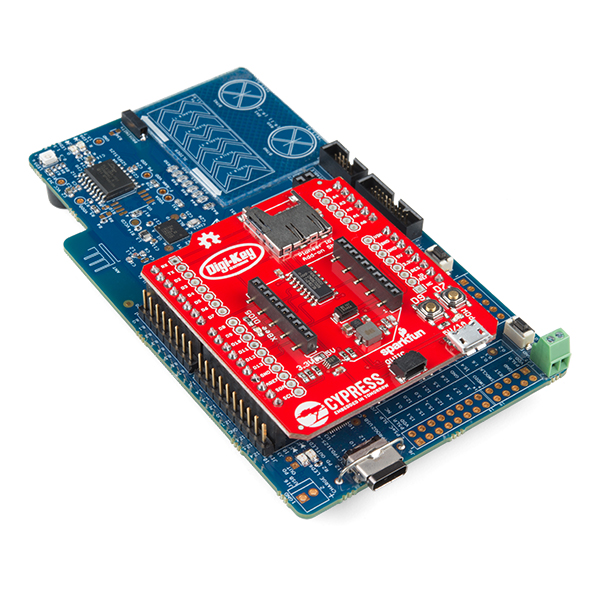Pioneer IoT Add-On Shield
The Pioneer IoT Add-On Shield is a unique board designed to add more functionality to the PSoC 6 from Cypress while remaining useful and practical for plenty of other Internet of Things applications. Each Add-On Shield is a pretty simple board with an equally simple layout that provides XBee, Qwiic and microSD functionality not only to the PSoC 6 but also to any board with an Arduino R3 shield format. On top of designing this board with a reliable IoT performance, we have written a guide that will show you how to communicate with a Raspberry Pi via Bluetooth® and WiFi, as well as how to communicate between a PSoC 4 BLE Pioneer Board and the PSoC 6 Pioneer Board via Bluetooth Low Energy.
In addition to the microSD card slot, XBee headers and Qwiic connector, the Pioneer IoT Add-On Shield is equipped with a micro-B USB connector. This connector provides 5V to the 3.3V regulator for the XBee module, overriding the 5V coming from the Arduino header and allowing high-power XBee modules to function properly. This is all thanks to the 3.3V regulator, level shift buffer, I2C level shift circuitry and a voltage supply selection jumper --- all found on the shield!
If you aren't familiar with it, the PSoC 6 Pioneer Board is the development tool associated with this processor line, sporting an onboard debugger, Arduino-compatible headers, CapSense widgets and more --- all tied to a PSoC 6 processor. The processor is a dual-core device, with a Cortex-M0+ low-power processor and a Cortex-M4 high-power processor tied together via shared peripherals and memory space.
- Arduino R3 Shield Layout
- XBee Header
- MicroSD Card Slot
- Qwiic Connector
- Micro-B USB Power Connector
- 3.3V Regulator
- Level Shift Buffer
- I2C Level Shift Circuitry
- Voltage Supply Selection Jumper
Pioneer IoT Add-On Shield Product Help and Resources
Using the PSoC 6 Pioneer Board with the Pioneer IoT Add-on Shield
February 1, 2018
Cypress's PSoC 6 Pioneer Board is a development tool for the powerful PSoC 6 processor. In this tutorial, we'll show you how to use the PSoC 6 Pioneer Board along with the SparkFun/Digi-Key Pioneer IoT Add-on Shield to send data to a Raspberry Pi via BLE or WiFi.
Core Skill: Programming
If a board needs code or communicates somehow, you're going to need to know how to program or interface with it. The programming skill is all about communication and code.
Skill Level: Rookie - You will need a better fundamental understand of what code is, and how it works. You will be using beginner-level software and development tools like Arduino. You will be dealing directly with code, but numerous examples and libraries are available. Sensors or shields will communicate with serial or TTL.
See all skill levels
Core Skill: Electrical Prototyping
If it requires power, you need to know how much, what all the pins do, and how to hook it up. You may need to reference datasheets, schematics, and know the ins and outs of electronics.
Skill Level: Rookie - You may be required to know a bit more about the component, such as orientation, or how to hook it up, in addition to power requirements. You will need to understand polarized components.
See all skill levels
Comments
Looking for answers to technical questions?
We welcome your comments and suggestions below. However, if you are looking for solutions to technical questions please see our Technical Assistance page.
Customer Reviews
3 out of 5
Based on 1 ratings:
3.3v to 5V jumper
When you make a revision make this a selector instead of a solder joint. Or at least move to a better area you can get into. Also I don't know if there a difference, probably not, but when I went to look for the PSoC 6 this goes on I found Digi-Key sold this board for $5.







I guess the PSoC 6 Pioneer has to be ordered from Digi-Key? The description doesn't make this very clear.
It can be purchased at Digi-Key or directly from Cypress. There are links in the hookup guide to the product pages.